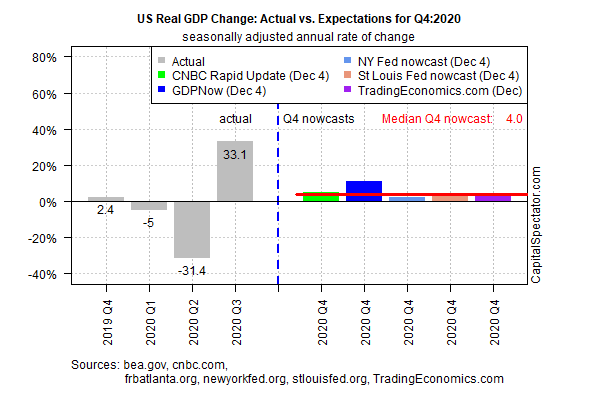Moderate Growth Outlook Holds For US GDP In Q4
As Covid-19 vaccines start to rollout in the West, the prospect of economic recovery strengthens. Many risks continue to lurk, of course, but for the first time since the pandemic started there are tangible signs of light at the end of the tunnel.
Today marks a milestone with news that a 90-year-old woman in the UK is the first person to receive the Pfizer COVID-19 vaccine outside of a trial. In the US, distribution of a vaccine could begin as early as this week. The main challenge is logistical and so widespread delivery to all 50 states will take months. In turn, a return to “normal” in the best-case scenario will have to wait until deep into 2021.
Meanwhile, Covid-19 cases are still spreading rapidly in the US and the pace of fatalities continues to rise. Over the past seven days through Dec. 7, the country has reported nearly 16,000 deaths, the deadliest week for the disease since April.
The pandemic seems likely to get worse before it gets better, but expectations for fourth-quarter GDP in the US continue to reflect moderate growth. Output is projected to rise 4.0% (seasonally adjusted annual rate), based on the median nowcast via a set of estimates compiled by CapitalSpectator.com. That’s down fractionally from the previous estimate, but the generally steady outlook is encouraging.

A new survey from the National Association of Business Economics (NABE) also sees growth at the 4% mark in the current quarter. “The NABE Outlook panel anticipates more moderate growth in economic activity going forward after the sharp rebound during the third quarter,” says NABE President Manuel Balmaseda. “The median forecast calls for a 4.1% annualized growth rate in the fourth quarter of 2020 for inflation-adjusted gross domestic product, or real GDP.”
Last week’s November release of the survey-based Composite PMI, a GDP proxy, also paints a comparatively upbeat profile for Q4. The index rose to 58.6 in November, well above the neutral 50 mark that reflects a solid pace of growth for overall economic output.

“November saw US business activity surge higher at a rate not seen since early-2015 as companies enjoyed sharply rising demand for goods and services,” says Chris Williamson, chief business economist at IHS Markit, which publishes the PMI data. “Confidence has picked up considerably, with encouraging news on vaccines coinciding with reduced political uncertainty following the presidential election, hopes of greater stimulus spending and fresh stock market highs. Optimism about the future is running at its highest since early-2014.”
What could go wrong? Unexpected glitches in the vaccine distribution and/or efficacy top the list. On the economic front, the pandemic’s ongoing fallout for the labor market is a key risk to monitor. In addition to signs that the growth in payrolls is slowing at a faster-than-expected rate, the continued high rate of layoffs each week remains a major threat to the economy.
The 700,000-plus loss of jobs, week after week, is on par with if not exceeds the worst points in recessions past. Although new filings for unemployment benefits fell to the lowest level in the pandemic, the 712,000 increase still represents a massive increase.

“The plunge in initial claims does not refute the idea that the trend is rising; we expected a sharp fall because of the difficulty of adjusting for Thanksgiving,” warns Ian Shepherdson, chief economist at Pantheon Macroeconomics. “Initial claims likely will rebound strongly next week [the weekly update due on Dec. 10], probably rising above the 800K mark for the first time in eight weeks.”
It’s always darkest just before the dawn, as the saying goes. That forecast still looks relevant for the weeks (months?) ahead. A vaccine may soon bring relief for a nation weary of lockdown and masks, but the current optimism for the economy remains vulnerable as the pandemic’s fallout accelerates in the winter months to come.
The coronavirus stimulus bill that’s circulating through Congress will help ease the pain, but politics continues to keep everyone guessing on whether there will be enough votes to pass the legislation.
Economic optimism, in short, remains a precarious thing. “News out of DC that fiscal stimulus talks have resumed is also a positive development (though until a deal actually passes the President’s desk, this might be all hat, no cattle),” advises Willie Delwiche, investment strategist at Baird. “These headlines come at a critical time as we remain in a challenging time from both a health and economic perspective.”
Disclosure: None.



